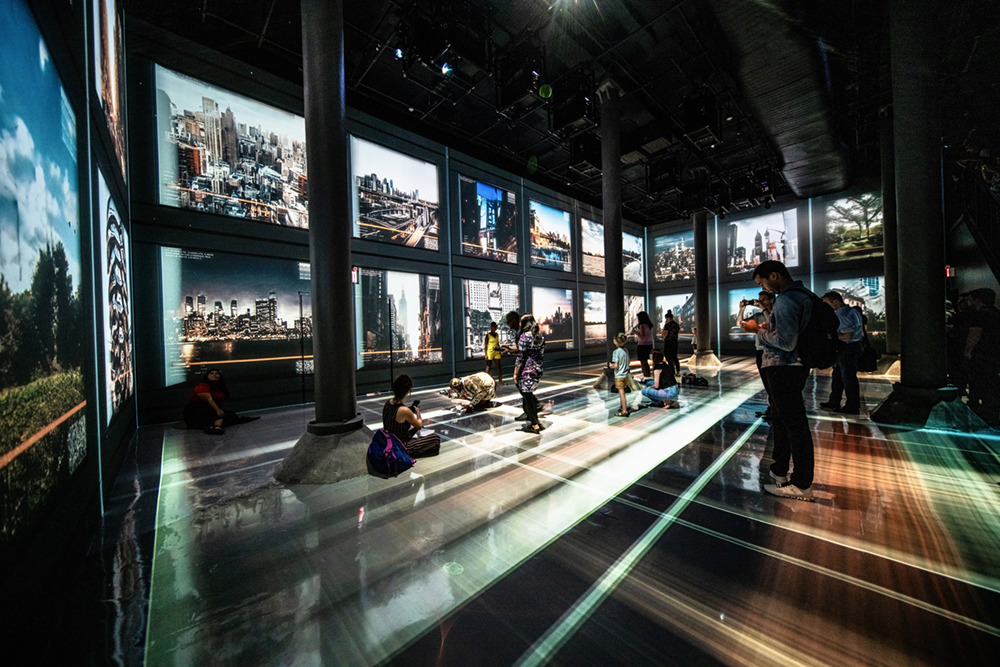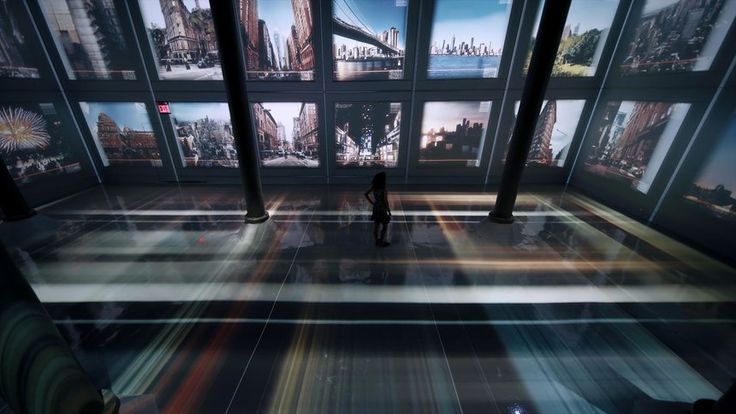Collective Memory of Surroundings with Alternative Perspectives
Artistic Narration of Data by Constructing the Memories of Humanity
View of Refik Anadol’s Installation Machine Hallucination. 18 Sept. 2019. Art in America, Penske Business Media, 2019, www.artnews.com/gallery/art-in-america/aia-photos/refik-anadol-at-artechouse/. Accessed 3 Oct. 2021.
An Aesthetic collective experience with “the other”. How does it sound to you? What does “the other” mean? Let me briefly explain. It is the being outside of yourself, an outsider point of view and perspective. It is a perception of space and time from different angles and from alternative perspectives. Then, what is a collective experience of space and time? It’s collective information. Yours and mine. Ours. It’s our data that obtains and provides information on how we perceive and experience our surroundings and even our lives. So here is the question, wouldn’t you want to vividly explore the various perspectives of our surroundings and space?
Nowadays, the human aspect and technology are more engaged with one and other due to the developing and growing aspiration for knowledge production and information. This engagement does not only provide technical configurations such as data but also expands to various fields to explore the potential of its insights through visualizing the patterns. Thus, information visualization could be explained as “the communication of abstract data through the use of interactive visual interfaces” (Manovich) that works as a bridge to concretely analyze and understand the complex patterns of a specified experience, in this case our surroundings and space, a collective experience.
Creating a collective perspective is possible through aesthetic visualization of data. Gathering your and my data to create an artistic visualization for a collective dimension to the archival representations of space. In a broad sense, aesthetic visualization set grounds for analyzing the data from a creative perspective with the purposes of “gaining attention as a means to promote a positive effect on perception of data in order to enhance experience and amplify the ability to obtain knowledge” (Li) through creating an emotional experience. Location based data is a large part of the visual production where the direct visualization of photos creates alternative views and perspectives for a single location-based identity. Gathering location-based photos makes it possible to expands our ability to observe space and time. By using location-based data visualization, Refik Anadol’s art work of Machine Hallucination explores an alternative reality through creating an aesthetically pleasing data experience of a narrative based time-lapse of spaces that provides “alternative spatial configurations or expose the way in which geographical landmarks are perceived.” (Colombo et al.) And going far beyond, Machine Hallucination: Space-Metaverse experience pushes the limits towards creating visual speculations for human’s attempts for exploring the Space and beyond.
Machine Hallucination: New York. 2020. British Design and Art Direction, 2020. Accessed 3 Oct. 2021.
Anadol’s Machine Hallucination art work based on 2019-2020 explores New York’s architecture throughout time and from various angles and perspectives through the mind of machine intelligence. Anadol uses Artificial Intelligence technology to gather 103 million archival photos of New York taken by citizens from various perspectives and angles throughout years. Anadol photoshops the human elements in the photos of NY by leaving only the architecture of the city and creates a narrative structure to establish a collective consciousness of this urban environment and an experience New York’s deeply hidden consciousness throughout time. Anadol states that “The project focuses on latent cinematic experiences derived from representations of urban memories as they are re-imagined by machine intelligence.” (Anadol) With his collective experience artwork, Anadol aims to pull the attention of people to explore the dimensions of data that “offers a unique context for us to explore an alternative reality.” (Anadol) The Installation provides a vision about the developing engagement of the human and technology by presenting another way to use the technological artifacts to explore the human, its consciousness, its urban life and even its being throughout time.
“How This Guy Uses A.I. to Create Art | Obsessed | WIRED.” YouTube, WIRED, 16 Jan. 2020, www.youtube.com/watch?v=I-EIVlHvHRM&t=208s. Accessed 3 Oct. 2021.
Anadol takes a bigger step after the Machine Hallucination Installation and recently presents a project that he has been working on with NASA JPL. The project is named Machine Hallucination: Space-Metaverse. The installation opens its doors to visitors from 30th of September 2021 till 4th of October in Hong Kong. Anadol gathers over 2 million photos of Space taken by NASA and Satellites and brings them together and creates an AI generated data art in order to understand human’s attempt patterns on exploring the Space. After Machine Hallucinations and the explorations of urban life, Anadol pushes the limits to find out more about what are the ways that human follow in order to understand its own creation and depths. By gathering the photos of the Space together, Anadol aims to present how technology and data can unite the past and present together and present a vision for future steps of human in exploring any and all alternative perspectives to understand its being with a collective memory of the machines.
Machine Hallucinations – Space: Metaverse. 2021. Sotheby’s, www.sothebys.com/en/digital-catalogues/machine-hallucinations-space-metaverse. Accessed 3 Oct. 2021.
To conclude, visualization of data plays an important role in understanding the narrative patterns of the actions taken. Either technology based or human based, the visualized data presents a vivid flow chart of the engagement between human and technology. Aesthetically visualizing the data creates another dimension to understanding the steps of human and gathers attention by appealing to human emotions. It targets people and their data, yours and mine, to engage with various other perspectives to unpack the patterns behind so that the future steps could be taken by calculating the effectiveness. Thus, with his artwork, Anadol presents an alternate to the so-called technology based apocalyptic future and suggests a way to narratively visualize the data of past and the present to envision the future of the human life. The question would be then, is it really the machine’s so-called consciousness that takes credit at the end or the human’s attempts in gathering the memories of past and present?
Works Cited
Anadol, Refik. Machine Hallucination. 2019. Refik Anadol, refikanadol.com/works/machine-hallucination/. Accessed 3 Oct. 2021.
Colombo, Gabriele, et al. “Visual Geolocations. Repurposing Online Data to Design Alternative Views.” Big Data & Society, vol. 4, no. 1, June 2017, p. 205395171770240. DOI.org (Crossref), https://doi.org/10.1177/2053951717702409.
“How This Guy Uses A.I. to Create Art | Obsessed | WIRED.” YouTube, WIRED, 16 Jan. 2020, www.youtube.com/watch?v=I-EIVlHvHRM&t=208s. Accessed 3 Oct. 2021.
Li, Qi. “Data Visualization as Creative Art Practice.” Visual Communication, p. 14.
Manovich, Lev. “What Is Visualisation?” Visual Studies, vol. 26, no. 1, Mar. 2011, pp. 36–49. DOI.org (Crossref), https://doi.org/10.1080/1472586X.2011.548488.
Machine Hallucination: New York. 2020. British Design and Art Direction, 2020. Accessed 3 Oct. 2021.
—. Machine Hallucinations – Space: Metaverse. 2021. Sotheby’s, www.sothebys.com/en/digital-catalogues/machine-hallucinations-space-metaverse. Accessed 3 Oct. 2021.
“Machine Hallucinations — Space : Metaverse.” NFT Collection. Sotheby’s. Accessed 3 Oct. 2021.
Tao, Feng, et al. “The Art of Human Intelligence and the Technology of Artificial Intelligence: Artificial Intelligence Visual Art Research.” Intelligence Science II, edited by Zhongzhi Shi et al., vol. 539, Springer International Publishing, 2018, pp. 146–55. DOI.org (Crossref), https://doi.org/10.1007/978-3-030-01313-4_15.
View of Refik Anadol’s Installation Machine Hallucination. 18 Sept. 2019. Art in America, Penske Business Media, 2019, www.artnews.com/gallery/art-in-america/aia-photos/refik-anadol-at-artechouse/. Accessed 3 Oct. 2021.

